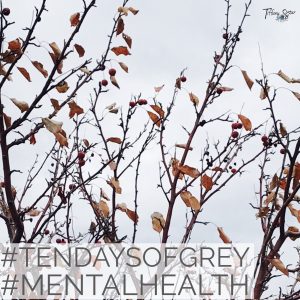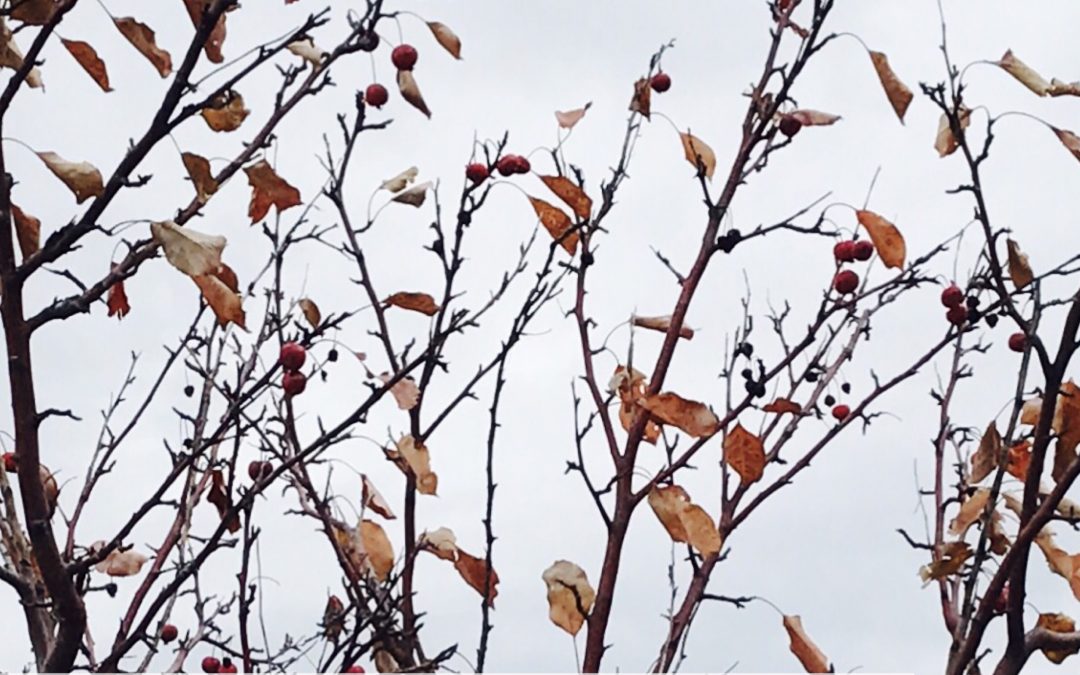Image description – Autumn leaves and berries on nearly bare twigs against a grey sky. Text reads #TenDaysOfGrey #Mental Health. There is a small Tiffany Sostar logo in the top right.
Content warning for discussion of depression, anxiety, self-harm, suicidality.
Today is World Mental Health Day. This is my final post for Bryan McLean’s #TenDaysOfGrey mental health awareness project. You can read my interview with Bryan here. Rather than writing something new for today, I’m sharing a post I wrote four years ago that detailed my mental health journey up to that point. The reason I’m sharing it at the end of the Ten Days of Grey is because when I wrote this post I was in the grey. I am in the colour now, and I appreciate that.
I wrote the post shared here in 2013. Now I am 36, it’s four years later and many things have changed and many things have stayed the same. I am thankful for my 32 year old self writing this. I am thankful for my 28 year old self making it through, for all those younger selves who made it through. I have spent so many years in the grey.
At 36, I am not depressed. (I am often anxious, I am in the middle of a three-months-and-counting fibro flare, and I am experiencing regular existential dread over the state of the world, but miraculously, I am not depressed. Wow!)
It is sort of amazing to reflect on that, because there is a lot going on in my life that would is difficult, stressful, and overwhelming. I am thankful for the resilience I have developed, and I am also conscious of the truth that these sorts of things are not always “overcomeable” and these monsters will visit again. I’ll make them tea, cry with them, and continue surviving. I am thankful for that confidence.
I am also amazed at how strategies shift. When I wrote this original post, I had a few coping skills that I leaned on daily – my extensive lip balm collection is a testament to that. I used lip balm application as an alternative behaviour to self-harming, and it was life-saving for me. But these days, I have only even felt the urge to self-harm once or twice in the last couple years, and I only use lip balm when my lips are chapped. Self-care is such a responsive process – we are always responding, and the act of self-care is an act of presence and awareness. It becomes habitual, but it can never be only habitual. I love (and hate) that iterative, never-ending process. (I also really miss my Patchwork writers! If I ran another six-week poetry writing course, would you be interested? Let me know!)
Here is my 2013 post, edited to remove some ableism (we are always learning!) and to update links.
I’m sitting in Vendome, one of my favourite cafès in Calgary. I just sent out the writing prompt to my Patchwork writers, posted it on the Facebook page, shared it on my personal Facebook, tweeted it, posted it on the Writing in the Margins blog. Most of the time I respond to writing prompts privately, in a longhand journal. If I share the writing later (which I rarely do, outside of workshops where I read my just-written work with the group), I type it up and polish it a bit.
But the prompt today is to write about mental health.
And I am a mental health advocate. So I am typing this response directly into my “add new post” screen, and I am going to hit “publish” when I’m finished. And then I’ll post a link to it on Facebook and on all of my Twitter accounts, and here’s why –
At 13, I went through my first serious depression. I did not know what was happening to me. (If you suspect that you may be going through a depression or other mental health concern, here is a free screening tool. It’s not perfect, and symptoms are not so cut-and-dried for many people – it is a place to start, but not a final word.)
Suddenly everything was awful. There was a pain in my body/brain/heart/soul. I cried a lot. I self-harmed. I scratched my neck and shoulders and hips and belly until I was cross-hatched, red and scabbing. I smashed my head into walls, sometimes until I was dizzy. I didn’t know who to talk to. The only person who knew I was self-harming, the only person I confided in, was my 9 year old sister. It was terrible for both of us, a weight far too heavy for her small shoulders (or my own).
Writing about this time, I feel my chest tighten and my breath shorten, the muscles in my neck knot up – these are the first physical manifestations of anxiety in my body and I am aware enough now, at 32, to recognize them for what they are. I take a deep breath, roll my shoulders, take a sip of water, continue.
In high school, at around 16 or 17, I went through a second (or perhaps just a worsening of my ongoing) depression. This was complicated by the arrival of Sadisty – a very angry, very vicious voice in my head. I do not seem to have a split or multiple personality disorder – Sadisty was just (“just”) my mind’s way of externalizing the intense self-loathing that I was experiencing. Though I feel a deep shame about what feels, to me, like one of the lowest points in my mental health journey, I am also amazed and grateful for whatever it was in me that did choose to externalize rather than internalize those feelings. Sadisty wanted me to die, and I had many moments of suicidality, but I didn’t want me to die. I put all of that negativity into Sadisty, to get it out of my own head, to make those nasty comments come in a voice that wasn’t my own.
I am lucky to have survived high school, to have survived Sadisty and that second/ongoing depression.
(Breathe again, breathe again.)
At 18, I started volunteering at the Calgary Humane Society. I adopted a dog, my soul mate. Tasha. She had separation anxiety and dog-dog aggression. She was anxious, fearful, aggressive. Helping her helped me. Things got better. Sadisty was gone, and she has never come back.
I got married, I got divorced.
My mental health stayed at a consistently low-grade level of self-loathing. Low self-esteem. An at-that-time undiagnosed anxiety disorder. The impact of early trauma, unacknowledged anxiety and low self-esteem on my sex drive led me to believe I was “sexually dysfunctional” (a whole other thing, related but tangential to this post).
(Breathe, breathe. Roll shoulders, stretch wrists, refill water. In my body right now – tightness, tension. Shame, anxiety, fear.)
After my divorce, I went through a third severe depression. Again, I was self-harming. Again, I was suicidal.
I was 28.
I was ashamed.
I felt foolish – this was supposed to be done, part of the horror of adolescence. How could it follow me into adulthood? How could it threaten to destroy the new life I was trying to build for myself? How could I?! Shame, anxiety, self-loathing – there was a toxic mix of emotions and beliefs at play. Fortunately, I was seeing a counsellor and had her support, and the support of my anchor partner. I had started seeing a counsellor when I was trying to get past the sexual dysfunction, and continued seeing her through my divorce and into the depression that followed it. I still see her, and will continue to do so. I recognize now that my neurodivergence is not something I will ever “overcome” – it is part of who I am. It has taught me invaluable lessons, and has helped me become the advocate that I am. At 32, I recognize the value that this neurodivergence has brought to my life.
But at 28, I climbed halfway over my 28th floor balcony, intending to make strawberry jam on the pavement below.
After that, my counsellor helped me come up with an emergency plan.
I made the painful call to my sister, my mom, my dad.
I said, “I am currently depressed. Sometimes I feel suicidal. I am calling to ask if you would be willing to be part of my emergency plan. What that would mean is that if I call and tell you that I am feeling suicidal, you will be available to come and be with me, or take me to the hospital if necessary.”
I had to euthanize Tasha.
My mom was hit by a truck, she almost died.
I experienced post-traumatic stress disorder. The depression got worse. The self-harming escalated.
My best friend stopped taking my calls. Months later, she told me that it had just gotten to be too much – there was something wrong every time we spoke.
Depression, anxiety, other mental health concerns… they can be like bombs, decimating at the point of impact, shrapnel flying everywhere. Relationships can be fundamentally altered or destroyed. Partnerships suffer. The ripple effects of a mental health issue can make the isolation and loneliness, the shame and fear and pain so much worse. Among the conversations that we do not have regarding mental health, this conversation about self-care for caregivers, and balancing the various and sometimes conflicting needs for support is both absent and necessary. It is possible to remain friends with a depressed person, but because we do not ever have this conversation, many people don’t know how.
I came out of that depression.
I became an activist.
I developed an amazing, diverse, wide-ranging social circle.
I learned new coping skills. I breathe more intentionally now. I pay attention to tension in my body. I rarely allow an anxiety attack to escalate to the point where I feel the urge to self-harm. I use lip balm and apply it when I start to feel anxious – I pay attention to the feel, the smell, the taste. I take supplements and get exercise. I see my counsellor every other week, more frequently when things get bad.
I am 32 now.
I am currently depressed.
I wake up in the morning and I feel sad. I feel hopeless. I feel discouraged.
I haven’t reconciled with the addition of fibromyalgia to my life. I miss my dad. I miss my dogs. I am financially unstable, and frustrated by my ongoing mental health concerns. I am immobilized by anxiety on a regular basis.
But I have help. And I have a purpose. I believe that my weakness is one of my superpowers, that my willingness to speak openly about my struggles is part of my activism.
So I am depressed.
I am waiting for it to be over (for now).
I use all my new coping skills. I lean on my friends, as much as I can allow myself, and I breathe. I stretch. I take my supplements and drink my water and have epsom salt baths to help with the physical pain.
It is World Mental Health Day.
And this is my mental health story.


